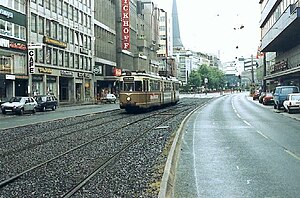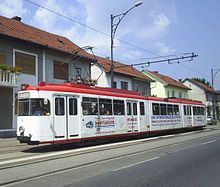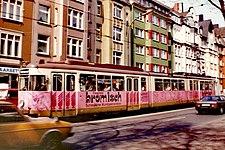GT8 (Dortmund)
| GT8 (Dortmund) | |
|---|---|
|
GT8 between Kampstrasse and Reinoldikirche
|
|
| Numbering: | 1-91 |
| Number: | 91 |
| Manufacturer: | DUEWAG, Hansa Waggonbau |
| Year of construction (s): | 1959-1974 |
| Retirement: | 1980-2001 |
| Axis formula : | Bo'2'2'Bo ' |
| Gauge : | 1435 mm ( standard gauge ) |
| Length over buffers: | 27,960 mm |
| Width: | 2,360 mm |
| Trunnion Distance: | 6,000 mm / 6,900 mm |
| Bogie axle base: | 1,800 mm |
| Service mass: | 32 t |
| Top speed: | 60 km / h |
| Hourly output : | 4 × 65 kW |
| Power system : | 600 volts = |
| Power transmission: | Overhead line |
| Number of traction motors: | 4th |
| Type of speed switch: | Cam switch |
| Seats: | 52 |
| Standing room: | 210 |
| Floor height: | 900 mm |
| Low floor: | 0% |
The eight-axle articulated tramway cars GT8 of the Dortmunder Stadtwerke are a series of 91 eight-axle Duewag articulated cars that were delivered between 1959 and 1974 and defined the image of the Dortmund tram in the 1960s, 1970s and 1980s. The vehicles were removed from the Dortmund tram fleet between 1981 and 2001 and some of them were handed over to the tram operators in Karlsruhe , Hiroshima , Wuppertal and Reșița .
construction

The vehicles are eight-axle, three-part, bi-directional articulated railcars with Jakobs bogies . The two conventional bogies at the bow and stern are powered. The car body is made of all-steel construction and its design follows the design of the 1950s with a rounded front section. The vehicles have four automatic, double-leaf folding doors on each side of the vehicle, with the middle part of the vehicle being designed without doors. The upper part of the side windows is designed as a vent window. Passenger information is provided by line and target film boxes integrated into the roof edge at the front and rear, as well as a line course display on each side of the vehicle in the middle section. The interior consists of tubular steel chairs with wooden covers. The seats are arranged in a compartment.
In contrast to most of the tram vehicles of the 1950s and 1960s, the vehicles have a single-axle drive with four pivot-bearing motors instead of a tandem drive . The control takes place with the help of crank-operated cam switches . Two pantographs are mounted on the vehicle roof, one on each of the two end car parts. The braking equipment consists of resistance brakes, pneumatic brakes, hand brakes and magnetic rail brakes.
With the manufacture and delivery of the last GT8 delivery series in 1974, it is the last tram cars manufactured by DUEWAG that were equipped with center- bearing motors .
The vehicles were painted ivory / brown. From 1986 onwards, some cars were given a red / white paint job analogous to the N8C and B80C. However, many vehicles had full advertising in different basic colors.
Delivery and use
The vehicles were delivered in five delivery series by Düwag and Hansa Waggonbau . The electrical equipment comes from Kiepe .
| Wagon number | Construction year | Manufacturer | comment |
|---|---|---|---|
| 41-60 | 1959 | Hansa | |
| 61-81 | 1959 | Düwag | |
| 16-40 | 1966 | Düwag | |
| 6-15 | 1969 | Düwag | 1973 renumbered 82-91 |
| 1-15 | 1974 | Düwag |
The vehicles were used on all Dortmund tram lines and displaced the two-axle vehicles and some of the four-axle articulated railcars by the mid-1970s. Due to their design as bidirectional vehicles, they could also drive to the end points without a turning loop.
Since the GT8 were not upgraded for use in the light rail tunnel opened in 1984, their use from this point on was limited to the remaining overground lines 403 (until 1985 409), 404, 406 and 408 (replacement for 402), while the light rail lines from 1978 N8C railcars delivered until 1983 and the B80C delivered from 1986 onwards.
With the conversion of further tram lines to light rail operation and the delivery of more light rail vehicles, the GT8 were replaced by other lines. The use of the vehicles in Dortmund ended in 2001.
Delivery and whereabouts
After the delivery of the second N8C series, the first GT8s became redundant in 1981. 20 of the vehicles, which were only 22 years old at the time, could still be handed over to the tram operators in Karlsruhe, Wuppertal and Hiroshima. The remaining vehicles were gradually taken out of service and scrapped in the following years. From 1996 another 22 vehicles were delivered to the Reșița tram.
Use in Karlsruhe
The Karlsruhe transport company took over a total of ten GT8s from Dortmund in 1981 and added them to their vehicle fleet under the numbers 216–225. They were mainly used as emergency vehicles , especially until 1983 on line 2E (Durlach – Rheinstrandsiedlung) and as a shuttle car in spring and autumn between Daxlanden and Rappenwört. After 1983, the cars were only used sporadically. One vehicle was handed over to the Wuppertal tram in 1985, the rest were scrapped between 1985 and 1990.
Use in Wuppertal
In 1983 the Wuppertal tram took over eight GT8s from Dortmund, and a ninth from Karlsruhe in 1985. The cars were given the numbers 3823-3831. Since the decommissioning of the Wuppertal tram had already been decided at this point in time, the vehicles were only used to bridge the gap until operations ceased. Two cars were withdrawn from the inventory in 1983, the rest were scrapped in 1987.
Use in Hiroshima
The Hiroshima tram took over the two GT8s 76 and 80 (renumbered to 77) in 1981. The two railcars were adapted to the local conditions for use. This included the installation of an air conditioning system, the lifting of the pantographs by means of a base installed underneath and the retrofitting of a new braking system, since the original brakes of the railcars did not comply with the requirements of the Japanese tram regulations. The two railcars were initially used in regular service, later mainly for special trips and were mainly used on the Miyajima railway line, which was separated from the actual tram network. Tw 77 was scrapped in 2006, Tw 76 was set up in 2012 as a café car next to the head office of the tram company. The café was closed in 2013, but the car remained there for a few more years. The car has been located in The Outlets shopping center in Hiroshima since 2018 , where it is used as a projection surface under the name The Warp Tram as part of the laser show of the same name . For this purpose, the car was painted completely in white, the windows were darkened. If desired, the car can be illuminated by several projectors using a smartphone app, with various color samples, background music and animation sequences available.
Deployment in Reșița
The Reșița tram in Romania received the first six surplus GT8s from Dortmund in 1996. Ten more cars followed in 1998, and six more in 2000. 20 vehicles were in use until the end of operation in 2011, but were scrapped in 2012.
Use as a work car
With bogies from two GT8s, the Dortmund municipal utilities built the 911 and 917 auxiliary vehicles between 1982 and 1985. The 911 car is used as a gravel transport truck, the 917 car is used as a rail transport truck with a crane. The trolleys are pulled or pushed by the N6C 902 work trolley .
Received vehicles
The following vehicles have been preserved:
- Car 13 has been in the local transport museum since 2018, set up as a café on Kampstrasse from 2010–2018
- Car 76 on display in a Hiroshima department store
- Car 87 in the Dortmund Local Transport Museum
Web links
literature
- Dieter Höltge, Günter H. Köhler: Trams and light rail vehicles in Germany. Volume 4: Ruhr area. EK-Verlag, Freiburg (Breisgau) 1994, ISBN 3-88255-334-0 .
- Martin Pabst: Paperback German streetcar railcars. Volume 2: Electric multiple units 1931 - today. Franckh'sche Verlagsbuchhandlung, Stuttgart 1982, ISBN 3-440-05043-2 .
- F. Teppe, A. Ahlers: Cult object on 16 wheels - The GT8 in Dortmund. Historical association of Stadtwerke Dortmund AG -Verkehrsbetriebe-, Dortmund 2008
- gallery
Individual evidence








